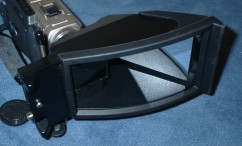
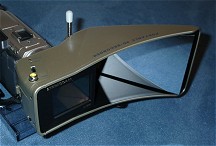
NuView vs. StereoCam
page initialy released: March 9, 2003
last update: -
Content
Introduction
Camcorder 3D-Adaptor Comparison
StereoCam and NuView in pictures
Purpose
Installation
Optics quality
Durability and workmanship
Filter mount thread
Cables
Compatibility
Shooting in 3D
3D-Glasses
StereoCam troubles
StereoCam 2D-mode
Lacking PC support
Legal concerns
Availability
Conclusion
related links
Original NuView review with general information
on 3D-camcorder adaptors
U-Bin Homepage
i-O Display Systems Homepage
WASOL Homepage
3Dquarium - beam splitter for photo-
and video-cameras
Snap-a-Cam - has plans for a 2-lens
consumer camcorder
StereoCam
article in Korea Now (engl.)
StereoCam
article in Korea Heute (german)
Introduction
The U-Bin StereoCam is similar in form and function to the i-O Display Systems NuView. Both adaptors turn an ordinary video-camera into a 3D-video-camera. All the basic functions and the fundamental advantages and disadvantages are the same. Therfore please read my original NuView review also! I don't want to repeat everything here.
 |
 |
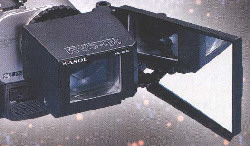 |
|
| company | i-O Display Systems, USA | U-Bin, Korea | WASOL, Korea |
| model | NuView SX-2000 | StereoCam UL-100 | 3D-CAM (not reviewed yet) |
| year of release | 1998 | 2001 | 1999 |
| dimensions in mm | L220 W105 H120 | 1.89inch x 2.64inch x 2.44inch | |
| net-weight | 550g | 320g | 233g |
| technology | LCD, prism polarizing beam splitter | LCD, flat polarizing beam splitter | ? |
| TV-standards | NTSC, PAL, Secam | NTSC, PAL, Secam | NTSC, PAL, Secam |
| supported frequencies | at least 50 and 60 Hz | at least 50 and 60 Hz | at least 50 and 60 Hz |
| video input | RCA (cinch) composite | RCA (cinch) composite | |
| video cable | RCA to RCA | RCA to RCA & 3.5mm (3 contacts) | |
| battery type | 1 x AAA | 2 x CR2032 | 2 x CR2032 |
| battery life | 50 hours | 50 hours | |
| auto-off function | yes | no | yes |
| horizontal allignment | large depth-control knob | large depth-control knob | |
| vertical allignment | with included allan key
via alignment hole |
with included screwdriver
via alignment hole |
|
| 2D-mode | no | yes | |
| left/right reverse switch | yes (hidden in casing) | yes (outside) | |
| indicators | ready and low-battery LED's | ready and low-battery LED's | |
| casing | mirror behind window | front of mirror unprotected | open mirror |
| case color | black | silver | |
| max. distance between tripod mount and device mount | 290mm | 150mm | |
| native filter thread size | 37 mm | 37 mm | |
| filter thread adaptors in package | 43mm, 49mm, 52mm
(ask for other sizes when ordering) |
27mm, 30mm, 30.5mm, 52mm
(ask for other sizes when ordering) |
|
| material | Engineering plastic | ||
| cover | small frontcover | bag | |
| bundled glasses | 2 I/O-Display i-ware! wired or wireless TV-shutterglasses | 1 Another I's wireless
TV-shutterglasses |
3D-Vision wireless
TV-shutterglasses |
| other extras | three IMAX 3D-DVD's in certain bundles | introduction video NTSC-VHS | |
| printed manual | 2 page english quick start card
13 page english manual (very good) |
15 page english manual (O.K., but bad print quality and non-native english) | |
| price | $250 with wired glasses and DVD's
$300 with wireless glasses and DVD's |
? |
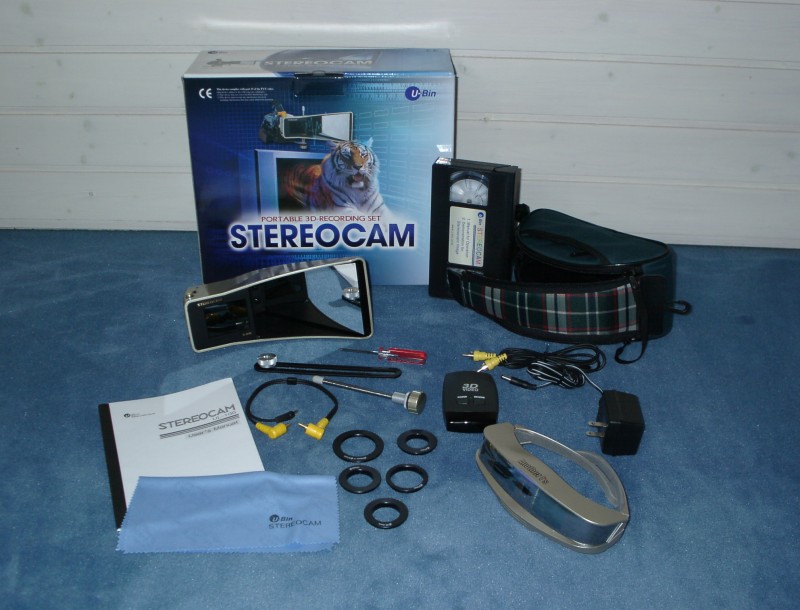
The complete U-Bin StereoCam set
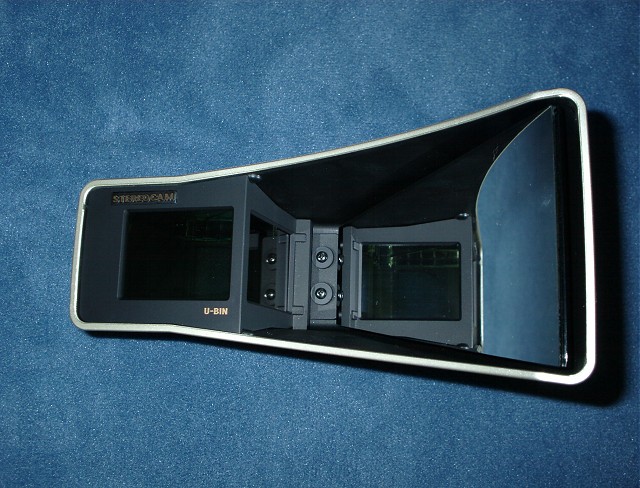
U-Bin StereoCam
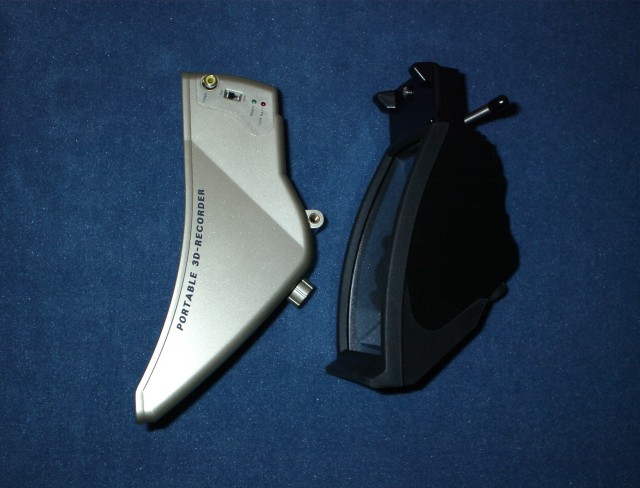
U-Bin Stereocam (left) and i-O Display Systems NuView (right)
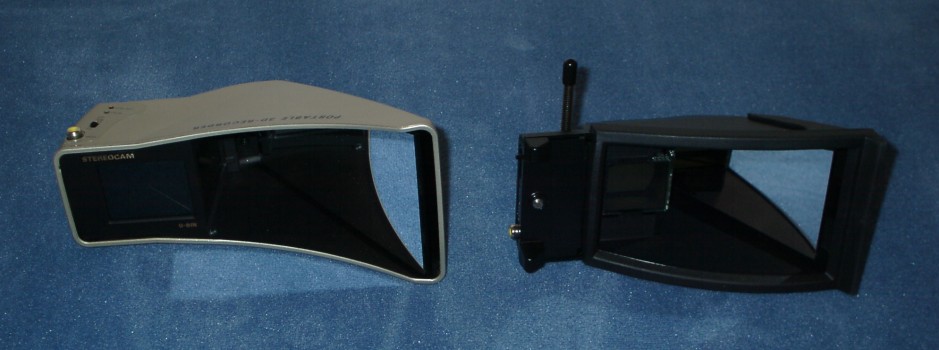
Full fronal nudity. The U-Bin Stereocam (left) is an open box with the
mirror exposed, while the i-O Display Systems NuView (right) has a large
front window
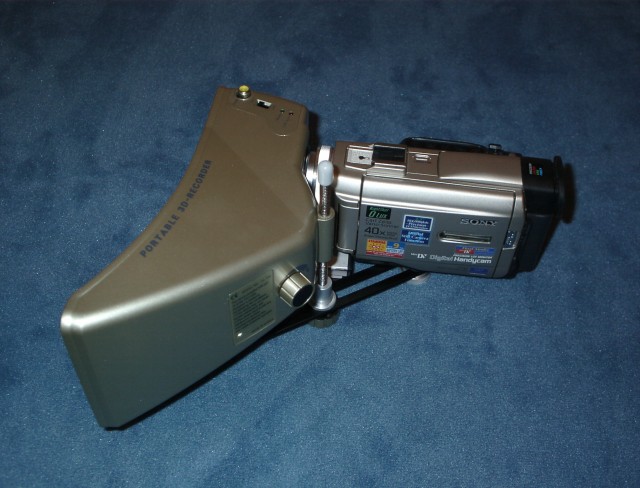
The StereoCam mounted to the Sony DCR-TRV10E, a typical mainstream miniDV
camcorder (the camera measures
L 158mm W 68mm H 89mm, 750g, 30mm filter mount)
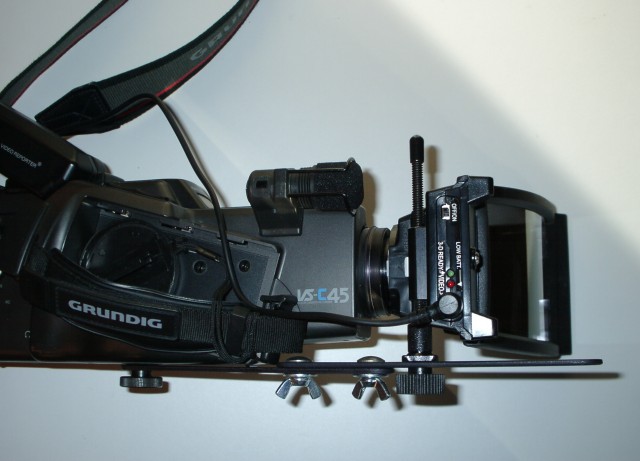
The NuView mounted to a large camcorder. Without the extra long double mounting bar this wouldn't be possible.
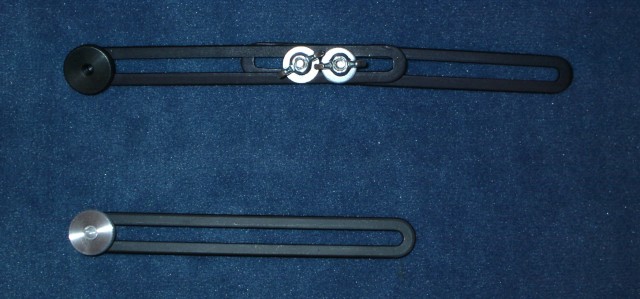
The NuView comes with two mounting bars (above) for larger camcorders. StereoCam comes with one bar (below)
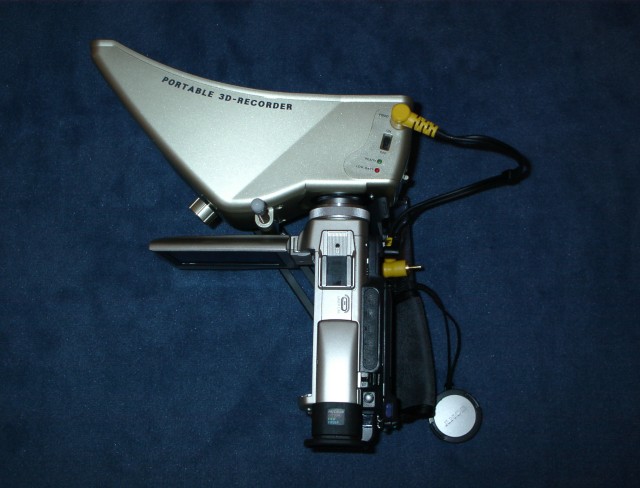
The LCD-monitor of the Sony is in the way of the depth-control knob
of the StereoCam, but it's still usable
with the monitor in this position, just a little uncomfortable
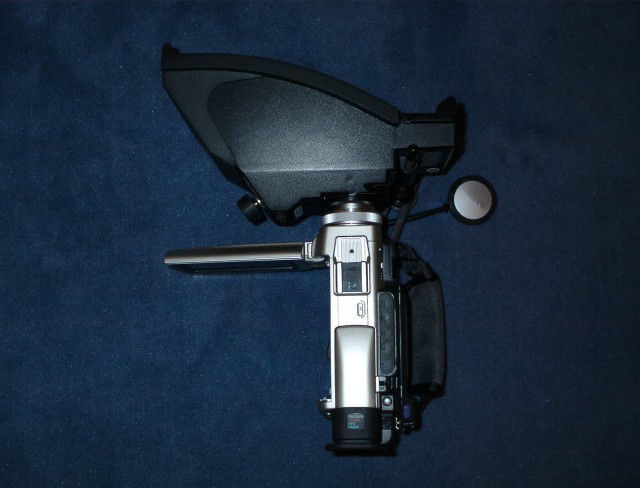
Only slightly better situation with the NuView, the LCD-monitor is in front of the depth-control knob, but it works.
The NuView didn't came with a 30mm filter mount adaptor, I used the
one from the StereoCam. Ask for the
proper filter mount adaptor when ordering either product.
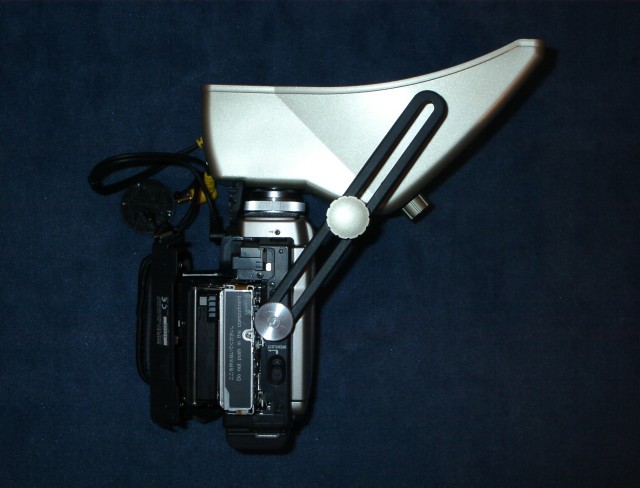
Changing the cassette on the Sony with the StereoCam installed is difficult, but possible.
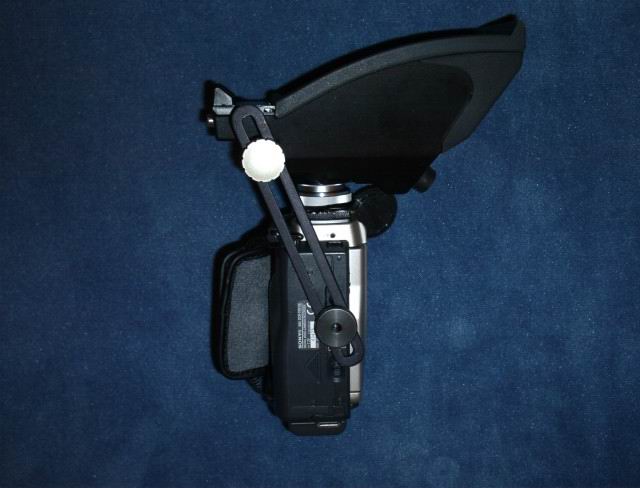
Changing the cassette on the Sony with the NuView installed isn't possible, but every camcorder is different.
Purpose of Stereo3D-Adaptors for camcorders
See my NuView review, StereoCam works similar
Installation and operation
See my NuView review, StereoCam works similar
Optics quality
The NuView uses a prism PBS (polarizing beam splitter) while the StereoCam
has a flat PBS.
In an interview
with 'Korea Now' the director of U-Bin said: "Although the prism PBS produces
a much better image than a flat PBS because of its ability to absorb more
light, it has the disadvantage of being more expensive and heavier," He
added that U-Bin developed a technology that absorbs as much light
as the prism-based PBS and therefore achieves the same results.
There may be differences in the optical properties of the two systems in terms of ghosting and reflections, but I don't have the means to analyze this in a professional way. With bare eyes I can't see it. There are differences in vignetting and parallaxes, but this may differ in relation to the camcorder used.
Durability and workmanship
Without a doubt the NuView leaves the heavier, sturdier, more professional impression. The price you have to pay for this is the higher weight.
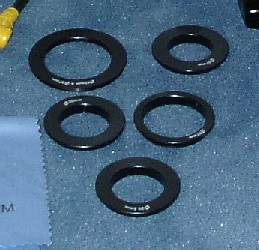
Filter mount thread
This is the show-stopper No.1 for both products. If the filter mount doesn't fit you are screwed. StereoCam comes with a better selection of filter thread adaptors, especially for smaller camcorders. When ordering either product ask for the proper filter adaptor for your camcorder. Apart from that it's good to have a healthy collection of adaptors in case you switch to another camcorder in the future. You don't know how long the companies behind StereoCam and NuView will be around. The filter adaptors are pretty unusual and different from the adaptors you get from the photo-shop.
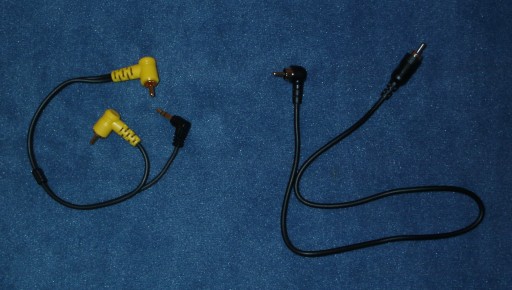
StereoCam cable (left) and NuView cable (right)
Cables
StereoCam comes with a 25 cm long RCA to RCA & 3.5mm 3-contact jack.
NuView comes with a 50 cm long RCA to RCA cable. StereoCams cable
also supports newer camcorders which have the small 3.5mm video connector.
(Newer packages of the NuView may come with different cables. You should
ask before ordering.) If you are in trouble you could also use the standard
cable provided with the camcorder, but usually these cables are rather
long.
Cover
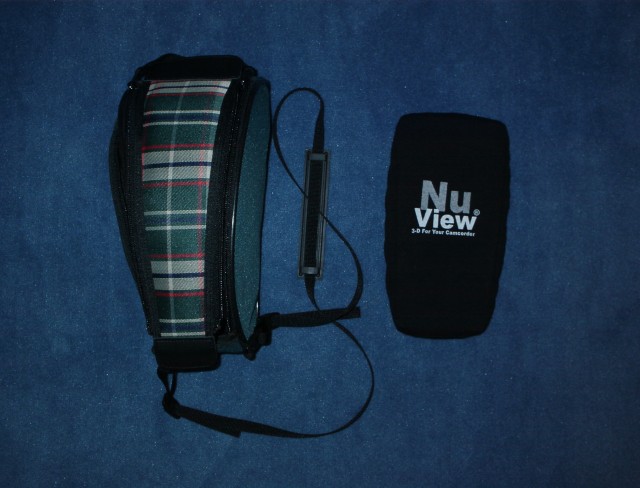
StereoCam comes with a bag, NuView with a front cover
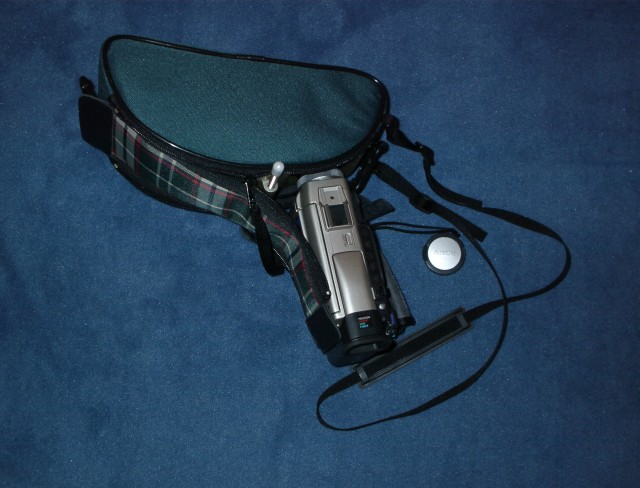
The StereoCam bagged while mounted
Compatibility
Both camcorder adaptors are designed for NTSC, PAL and SECAM camcorders. The composite video signal from the camcorder is feeded into the device for synchronization. In theory the technology is also compatible to interlace format HDTV standards, such as 1024i. The question remains if the electronic in the camcorder-adaptors could derive the sync from such a HDTV signal.
The playback requires a non-digital standard TV-set. Old 50/60 Hz TV-sets
which support the StereoCam and NuView directly are dying out. Here in
Germany they are already dead. Even the cheapest no-name TV-sets from the
supermarket are equiped with digital 100 Hz technology already.
There are more and more LCD and Plasma TV's as well as LCD-, DLP-,
D-ILA, LCoS and - in the future - Laser projectors which are incompatible
with the format produced by NuView and StereoCam.
The camcorders get smaller and lighter. Some even don't have a filter mount anymore. There will be digital camcorders which use progressive scan and compression technologies such as MPEG4 which destroy the 3D-information.
All in all the mass-market environment for these 3D-products becomes smaller. Fortunately most of us have some older TV-set somewhere which can be used for playback.

The large knob in the middle is the 'depth knob', which controls horizontal parallax
Shooting in 3D
In real life our eyes converge on the object we are focusing. On a close
object the eyes turn inwards. In an ideal case the parallax we see of a
focused object is zero.
This effect of converging is simulated with the StereoCam and the NuView
by the 'depth-knob'. With this knob the mirror is moved and the user can
control the parallax. When looking through the camera viewfinder you see
a double image. What you do is to choose the object of main interest, lets
say a person, and focus the camera on it. Now you rotate the depth-knob
until the main-object isn't doubled anymore. In your 3D-video this main
object will appear on the plane of the screen. All objects in front of
this main-object will come out of the screen and all objects behind the
main-object will be inside the screen. You have to carefully choose the
object which should be on this zero-parallax plane. Excessive out-of-screen
effects will cause eyestrain and headaches.
You have to carefully plan your shots. If you select a close object as the plane of zero-parallax and pan to far away objects you will produce excessive parallaxes. Often I got so large parallaxes, especially from the StereoCam, the viewer later won't see them as a stereo-image, but just as a double-image. If the parallax is too large the brain can no longer merge the two images.
Both products also have a vertical parallax control, which is very important, but shouldn't be used often. The adaptors must be properly installed in a 90 degree axix against the main axis of the camcorder, in other words exactly horizontal. Otherwise you get a vertical parallax which must by avoided at any cost. If the adaptor is correctly alligned, but there's still a vertical parallax this can be fixed. The NuView comes with a small allen-key and the StereoCam with a special screwdriver to do this. Both have a small vertical allignment hole to manipulate the vertical axis of the mirror.
Both adaptors produce some 'vignetting' when you go into wide-zoom. Parts of the adaptor mounting becomes visible as dark border in the image. The effect depends on the size and zoom-factor of your lens. With the Sony camcorder I had more troubles here with the Stereocam, but this may be different with other lenses.
Both adaptors are vulnerable to mechanical interference. It is enough to you squeeze the housing of the adaptor slightly with the hand to change the parallax, so don't grap is too hard while shooting.
Both adaptors have a pass-through tripod adaptor mount if you will. The screw which goes into the cameras original tripod mount has it's own mount. This solution isn't very stable. When turning the camera on the tripod the screw starts to rotate.
3D-Glasses
The StereoCam comes with wireless Another I's shutterglasses and the Another I's TV-controller/emitter. These are bulky glasses and the plastic visor on the front looks cool, but distorts the vision. If you end up with the Another I's try to remove the front-visor! NuView is bundled with some wired or wireless (optional) i-O-Display glasses and a TV-controller/emitter. The glasses are light and provide good optical quality. So I think NuView is the winner in the glasses department.
StereoCam troubles
When I first tested the StereoCam it didn't work. After a few seconds
of flickering the internal shutter stopped working and the 'battery low'
warning LED went on. I tried tons of new batteries to no avail. Much later
I found that there was something wrong with the 2D-Left-Right selection
switch. I mounted the StereoCam to the left of the camcorder and had the
switch in left-position. Actually this wasn't the full left position. The
switch was inbetween right and left position. There is a misalignment between
the switch and the StereoCam casing, so the left position wasn't fully
reached. Now I use the right position, although the adapter is mounted
to the left. I have to use the reverse switch on the shutterglasses-controller.
It is generally a good idea to stay away from shutterglasses-controllers,
which don't have a manual reverse switch.
StereoCam 2D-mode
The 2D-mode of the StereoCam allows normal, monoscopic shooting in full resolution without a long deinstallation procedure. One of the views is permanently blocked by the internal LCD-shutter. The resulting 2D-video looks pretty normal. I couldn't see ghost-images from the other perspective view. This is another proof that LCD-shutters do block light efficiently and that phosphor-afterglow in the TV or monitor-tube is the main cause of ghosting.
Lacking PC support
What is missing in both packages is the hard- and software to transfer,
store, edit, convert, manipulate, title and display the stereo videos on
the PC.
Furthermore such a hard- and software package doesn't seem to exist
at all. There is some suitable hard- and software, but you have to collect
it and do a lot of research by yourself. This is definetely for freaks
only and not mature enough for the mass-market. In my opinion this is the
biggest minus of both products.
There should be an easy-to-use software which lets you transfer your digital (miniDV or D8) 3D-video to the PC via firewire. Here it should be possible to convert it to other 3D-formats, such as over-under or anaglyph. The resulting PC-3D-video should be saveable as miniDV, MPEG1, MPEG2 or DivX. There should be a player-software which can display the over-under video as in different stereo formats for shutterglasses, anaglyph glasses and HMD's. The original over-under video could be viewed with sync-doubler glasses, such as eDemensional, I/O-glasses, 60GX-NSR, i-Art, H3D, etc. The over-under format can also be edited with any editing software without destroying the 3D-information and it doesn't waste resolution either! If you take an interlace 60 Hz digital video which actually has 720x240 per half-frame (TV-standard) and convert it into a 30 frames-per-second 720x480 progressive (DVD-standard) over-under video you don't have a loss in resolution or 3D-information!
Old non-digital 50/60 Hz TV-sets which support the StereoCam and NuView directly are dying out. 3D-video has to migrate to the PC or it's worthless!
Legal concerns
The NuView was developed by the US-company 3D-Video Inc. in the
90's and released in 1998.
U-Bin was established in March 2001 and their StereoCam is so similar
in form and function to the NuView one may consider it a rip-off.
Furthermore the US-company HinesLab
Inc. already has a trademark on a professional product also called
'StereoCam'.
Availablity
The NuView is available worldwide directly from i-O Display and from many dealers. The StereoCam seems to be hard to find outside Asia.
Conclusion
Editing and playback of 3D-video remains a problem. There should be an easy to use package for bringing the 3D-videos to the PC. I can't see much mass-market potential for 3D-camcorder-adaptors, but for the 3D-addict they are a must-have considering the low-price and impressive results.
Both the NuView and the StereoCam are equal in form and function and both deliver the goods, although I had a somewhat harder time with the StereoCam. Both turn your camcorder into a 3D-machine at bargain prices. The NuView is the heavier, sturdier, more reliable, more professional product and still comes at a low price. It also has the hotter bundle consisting of better shutterglasses and optional 3D-DVD's. The StereoCam has the big plus of the lower weight and the 2D-mode. StereoCam's bag and somewhat better filter-adaptor collection are other goodies. If you have a small, light camcorder and if the price is right you may go against the odds and for the StereoCam - if you can find a dealer. Otherwise go for the NuView, but don't forget to ask for the proper cables and filter-adaptors.
StereoCam 2002 package sample was provided by U-Bin
NuView original 1998 package sample was provided by 3D-video Inc.
NuView i-O-Display 2001 package sample was provided by digital-3d-media
Brand and product names are trademarks or registered trademarks of their
respective holders.
The author doesn't guarantee the accuracy of the information given on this
page and takes no liabilities.
The text on this
page is the intellectual property of the author.
Don't copy any part
of it without credit and link to this site!

